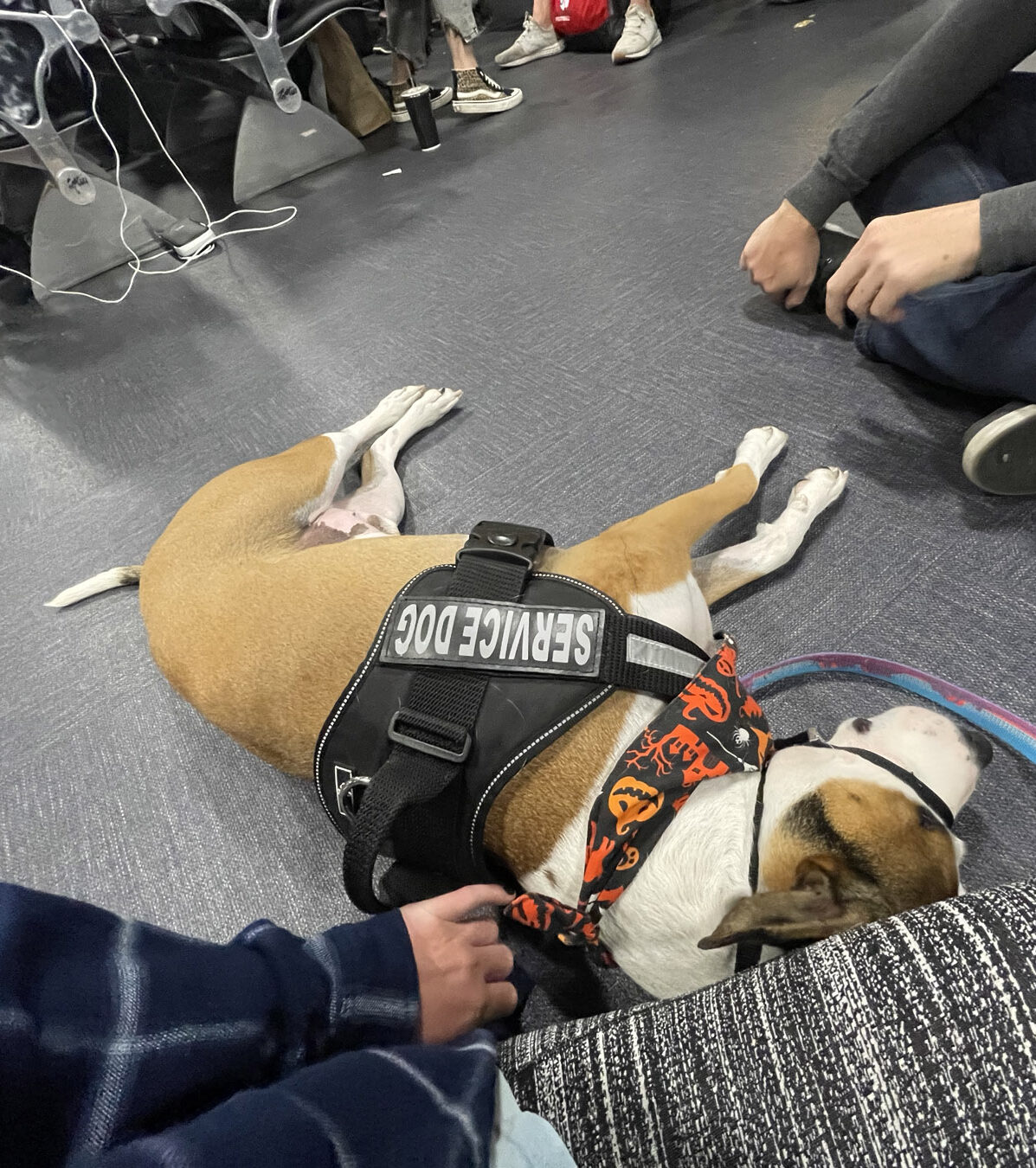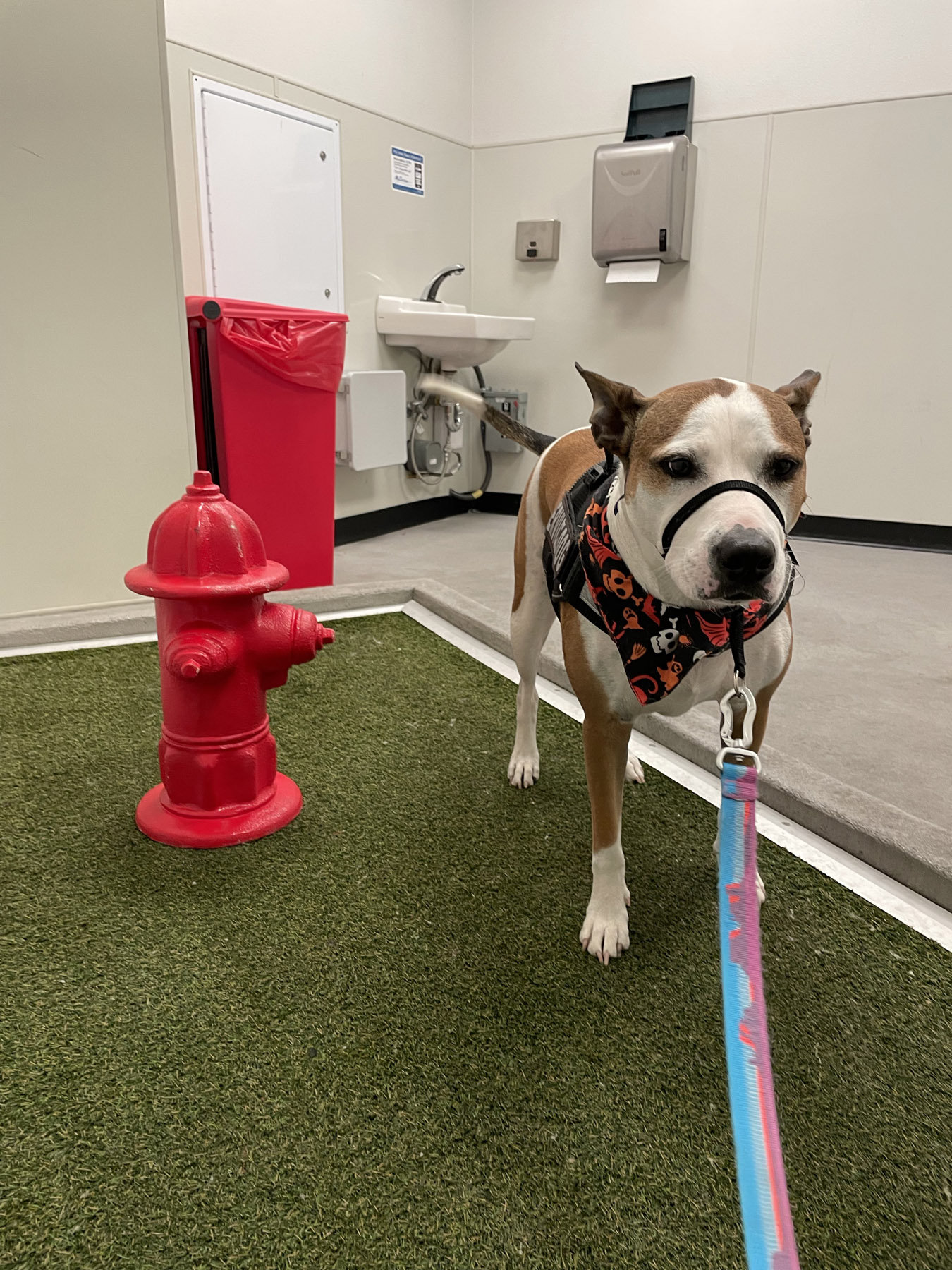
This service dog journey has been nothing short of a JOURNEY. It’s way more complicated and convoluted than it needs to be.
I have several friends who are interested in getting their pups “certified”* as service dogs, so I wanted to have one central place to share everything that Oscar and I have learned!
*“Certified” in quotes, because there is no official service dog certification process in the U.S. There are plenty of companies that want to scam you into thinking there is though!
What is The Public Access Test?
On that topic, the only legitimate resource I have found is what’s known as the “Public Access Test”.
This is a standardized test that professional service dog trainers use as a rubric basically. From my own research, these are the main requirements…
The dog must have the ability to:
- Safely cross a parking lot, halt for traffic, and ignore distractions.
- Heel through narrow aisles.
- Hold a Sit-Stay when a shopping cart passes by or when a person stops to chat and/or pets the dog.
- Hold a Down Stay when a child approaches and briefly pets the dog.
- Hold a Sit Stay when someone drops food on the floor, hold a Down Stay when someone sets a plate of food on the floor within 18″ of the dog, then removes it a minute later. (The handler may say “Leave It” to help the dog resist the temptation.)
- Remain calm if someone else holds the leash while the handler moves 20 ft. away.
- Remain calm while another dog passes within 6 ft. of the team during the test. This part can occur in a parking lot or store. Alternatively, you could arrange for a neighbor with a pet dog to stroll past your residence while you load your dog into a vehicle at the beginning of the test.
- Be able to complete at least two service-related tasks to help with your disability—see a list of options here. (Oscar and I chose Tactile Stimulation and Deep Pressure Therapy, for now)
These aren’t that intimidating (if your dog isn’t super wild), but I feel like there are a lot of intricacies within these steps. All of the commands, such as sit, stay, stop, down, heel, side, leave it, etc. take quite a while to train for and all add up to make up this list.
To put it in perspective, Oscar has learned all of these throughout his three Petsmart training classes (Beginner, Intermediate, Advanced)—which in total took 18 weeks (4.5 months)—and that’s not including his behavioral/public training. Not saying that to scare anyone, but just trying to show a realistic timeline!
I always read that service dog training takes at least six months and thought that was extensive, but it is pretty accurate.
What are the Training Time Requirements?
- 120 total hours of training
- 30 of those hours (minimum) have to be in a public setting
After Oscar and I’s personal experience, I would say this is pretty good standard to follow. I started feeling very comfortable taking Oscar out and about right after we hit the 30-hours in public mark.
I HIGHLY recommend keeping track of your training hours, so that you can track progress, and so you can show it to anyone who questions your service dog’s legitimacy. I didn’t keep track until pretty far into the process, and wish I had been more detailed about what type of training I did and when—i.e. shopping in public, versus daily walks and practicing commands, etc.

Do I Need a Service Dog Certification?
Once again reiterating: THERE IS NO OFFICIAL CERTIFICATION FOR SERVICE DOGS IN THE U.S. Do not be scammed. Sure, you can pay for training or courses or videos or whatever, but don’t believe that the “certificate” they give you at the end is worth anything more than a piece of paper.
If I sound salty, it’s because I am hahaha. Thankfully I didn’t pay for any fake certifications, but I almost did on multiple occasions, and was very stressed trying to figure out what was legit and what wasn’t.
For me personally, as I mention in my post about Oscar’s first flight, I got a letter from a licensed mental health professional just as additional credibility that I DO in fact need a psychiatric service dog for a mental disability. I keep this with me just in case anyone protests it, and turn it in to the airlines with my DOT forms. Again, this is not required, but optional…for me, it makes me feel a little more at ease. Another benefit of having this letter (or an Emotional Support Animal letter if you go that route instead), is that an apartment or rental cannot deny your dog from living with you, regardless of breed/size restrictions or any other reasons. Legally, service dogs are protected by the ADA in a lot of ways. Fun fact!

Should I Hire a Professional Service Dog Trainer?
This is one big ‘ole confusing topic.
I made the decision to self-train Oscar, with the help of Youtube videos, online resources, and Petsmart training. I got very lucky in that our Petsmart trainer also trains therapy dogs (the ones who work in hospitals and schools), so he has been able to give some extra advice and help in getting Oscar ready for the service life. Shoutout to Mike at Petsmart in Westminster, Colorado!
I remember when I first started this journey, I thought there was no possible way I could do it myself and was very anxious about the idea of it. I did tons of research on both local and virtual service dog trainers, and came out very disappointed. They are either overbooked and not taking new clients, are only taking disabled veteran clients (which is understandable), or they charge $5K minimum for service dog training. Idk about you, but I definitely don’t have that kind of money laying around for dog training.
The cost was my main reason for self-training; believe me, I would’ve LOVED to have someone else handle it all and pass off a lovely, well-behaved pup to me with no effort on my part. Also I would feel more “official” and “legit” if I had a professional train him. BUT, I have to say I’m very glad I decided to DIY it.
Not only did I save some serious cash (and had to deal with a LOT of frustrating training moments), but I feel like Oscar and I have a muuuuuuch stronger bond now. Not only did we have to spend a ton of time together, but—as woo woo as this sounds—we have learned to trust and respect each other on another level. We both know how to read each other. Sometimes I feel like I’m his service human too, LOL.
Oscar’s Stats + Fun Facts:
- He’ll be turning 6 years old in February 2023
- He started Petsmart Beginner training at 4.5 years old (pretty late to the game), and is now about to complete Intermediate and Advanced at 5.5 years old
- He weighs 65 lbs of pure muscle (not the daintiest and easiest to travel with)
- He was a rescue pup from a shelter, he and his siblings were left in a box on the side of the road 😭
- Prior to training, he was a very wild boi
- He’s a social butterfly, and a major cuddler
- My friend Kostas calls him “the love trap” 😂❤️

All that being said—I am not a service dog expert. I’m just sharing my experience and what I’ve learned. Feel free to do your own research, but I hope this helps to give you a leg up in a very complex process!









